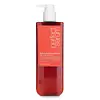What's inside
What's inside
 Key Ingredients
Key Ingredients

 Benefits
Benefits

 Concerns
Concerns

 Ingredients Side-by-side
Ingredients Side-by-side

Water
Skin ConditioningGlycerin
HumectantDipropylene Glycol
HumectantDimethicone
EmollientCetyl Alcohol
EmollientStearyl Alcohol
EmollientBehentrimonium Chloride
PreservativeCaprylic/Capric Triglyceride
MaskingIsopropyl Alcohol
SolventParfum
MaskingHydroxyethylcellulose
Emulsion StabilisingDisodium EDTA
Ethylhexylglycerin
Skin ConditioningHexyl Cinnamal
PerfumingBenzyl Salicylate
PerfumingHc Yellow No. 4
CI 19140
Cosmetic ColorantArgania Spinosa Kernel Oil
EmollientCamellia Seed Oil
Abies Alba Seed Oil
AntimicrobialOlea Europaea Fruit Oil
MaskingSimmondsia Chinensis Seed Oil
EmollientCocos Nucifera Oil
MaskingCI 17200
Cosmetic ColorantTocopherol
AntioxidantCoco-Caprylate/Caprate
EmollientSclerocarya Birrea Seed Oil
HumectantGlycolipids
Skin ConditioningWater, Glycerin, Dipropylene Glycol, Dimethicone, Cetyl Alcohol, Stearyl Alcohol, Behentrimonium Chloride, Caprylic/Capric Triglyceride, Isopropyl Alcohol, Parfum, Hydroxyethylcellulose, Disodium EDTA, Ethylhexylglycerin, Hexyl Cinnamal, Benzyl Salicylate, Hc Yellow No. 4, CI 19140, Argania Spinosa Kernel Oil, Camellia Seed Oil, Abies Alba Seed Oil, Olea Europaea Fruit Oil, Simmondsia Chinensis Seed Oil, Cocos Nucifera Oil, CI 17200, Tocopherol, Coco-Caprylate/Caprate, Sclerocarya Birrea Seed Oil, Glycolipids
Water
Skin ConditioningCetearyl Alcohol
EmollientSteartrimonium Chloride
PreservativeDimethicone
EmollientParaffinum Liquidum
EmollientHydroxyethylcellulose
Emulsion StabilisingParfum
MaskingPEG-100 Stearate
Glyceryl Stearate
EmollientBenzyl Alcohol
PerfumingAmodimethicone
Phenoxyethanol
PreservativeSodium Benzoate
MaskingDisodium EDTA
Argania Spinosa Kernel Oil
EmollientPanthenol
Skin ConditioningCitric Acid
BufferingAloe Barbadensis Leaf Juice
Skin ConditioningDimethiconol
EmollientAstrocaryum Murumuru Seed Butter
EmollientCocodimonium Hydroxypropyl Hydrolyzed Keratin
Skin ConditioningButylene Glycol
HumectantHydroxyacetophenone
AntioxidantPotassium Sorbate
PreservativeWater, Cetearyl Alcohol, Steartrimonium Chloride, Dimethicone, Paraffinum Liquidum, Hydroxyethylcellulose, Parfum, PEG-100 Stearate, Glyceryl Stearate, Benzyl Alcohol, Amodimethicone, Phenoxyethanol, Sodium Benzoate, Disodium EDTA, Argania Spinosa Kernel Oil, Panthenol, Citric Acid, Aloe Barbadensis Leaf Juice, Dimethiconol, Astrocaryum Murumuru Seed Butter, Cocodimonium Hydroxypropyl Hydrolyzed Keratin, Butylene Glycol, Hydroxyacetophenone, Potassium Sorbate
Ingredients Explained
These ingredients are found in both products.
Ingredients higher up in an ingredient list are typically present in a larger amount.
You may know this ingredient as argan oil. Argan Oil has antioxidant, hydrating, and soothing properties.
Studies have shown argan oil can help fight again radical damage from the sun. This makes it effective at preventing hyperpigmentation.
Large amounts of vitamin E found in argan oil helps the skin retain water. Argan oil also contains fatty acids such as linoleic acid, oleic acid, and palmitic acid. It is also a good source of lipids.
Another benefit of argan oil is skin-soothing. It can help reduce inflammation-related skin symptoms.
Argan Oil is effective at regulating sebum production in pores. This can make it effective at treating hormonal acne.
Traditionally, argan oil was used for its antibacterial and antifungal properties. However, argan oil contains fatty acids that may make it not fungal-acne safe.
Argan Trees are native to Morocco.
Learn more about Argania Spinosa Kernel OilDimethicone is a type of synthetic silicone created from natural materials such as quartz.
What it does:
Dimethicone comes in different viscosities:
Depending on the viscosity, dimethicone has different properties.
Ingredients lists don't always show which type is used, so we recommend reaching out to the brand if you have questions about the viscosity.
This ingredient is unlikely to cause irritation because it does not get absorbed into skin. However, people with silicone allergies should be careful about using this ingredient.
Note: Dimethicone may contribute to pilling. This is because it is not oil or water soluble, so pilling may occur when layered with products. When mixed with heavy oils in a formula, the outcome is also quite greasy.
Learn more about DimethiconeDisodium EDTA plays a role in making products more stable by aiding other preservatives.
It is a chelating agent, meaning it neutralizes metal ions that may be found in a product.
Disodium EDTA is a salt of edetic acid and is found to be safe in cosmetic ingredients.
Learn more about Disodium EDTAHydroxyethylcellulose is used to improve the texture of products. It is created from a chemical reaction involving ethylene oxide and alkali-cellulose. Cellulose is a sugar found in plant cell walls and help give plants structure.
This ingredient helps stabilize products by preventing ingredients from separating. It can also help thicken the texture of a product.
This ingredient can also be found in pill medicines to help our bodies digest other ingredients.
Learn more about HydroxyethylcelluloseParfum is a catch-all term for an ingredient or more that is used to give a scent to products.
Also called "fragrance", this ingredient can be a blend of hundreds of chemicals or plant oils. This means every product with "fragrance" or "parfum" in the ingredients list is a different mixture.
For instance, Habanolide is a proprietary trade name for a specific aroma chemical. When used as a fragrance ingredient in cosmetics, most aroma chemicals fall under the broad labeling category of “FRAGRANCE” or “PARFUM” according to EU and US regulations.
The term 'parfum' or 'fragrance' is not regulated in many countries. In many cases, it is up to the brand to define this term.
For instance, many brands choose to label themselves as "fragrance-free" because they are not using synthetic fragrances. However, their products may still contain ingredients such as essential oils that are considered a fragrance by INCI standards.
One example is Calendula flower extract. Calendula is an essential oil that still imparts a scent or 'fragrance'.
Depending on the blend, the ingredients in the mixture can cause allergies and sensitivities on the skin. Some ingredients that are known EU allergens include linalool and citronellol.
Parfum can also be used to mask or cover an unpleasant scent.
The bottom line is: not all fragrances/parfum/ingredients are created equally. If you are worried about fragrances, we recommend taking a closer look at an ingredient. And of course, we always recommend speaking with a professional.
Learn more about ParfumWater. It's the most common cosmetic ingredient of all. You'll usually see it at the top of ingredient lists, meaning that it makes up the largest part of the product.
So why is it so popular? Water most often acts as a solvent - this means that it helps dissolve other ingredients into the formulation.
You'll also recognize water as that liquid we all need to stay alive. If you see this, drink a glass of water. Stay hydrated!
Learn more about Water